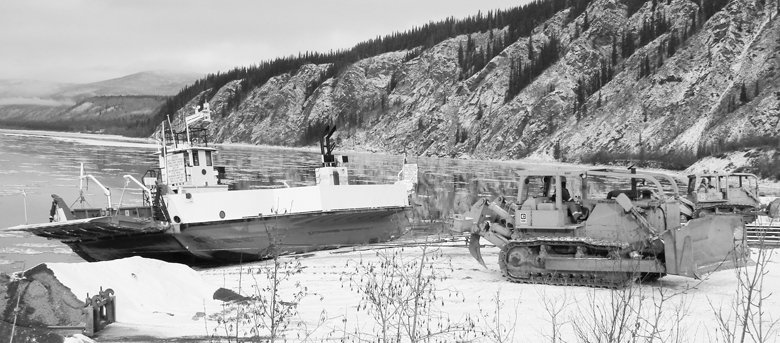By Dan Davidson
It seemed early to some, but the George Black Ferry actually came out of the river on October 27, two days later than last year, and around the same as it does most years. Casting back over the last few extractions, it’s been as late as November 2, but the timing is fairly normal.
The projected layoff date for the crew, hence the pullout date as well, had been November 2, but the previously crystal clear Yukon River began to show floating panes of fragile frazil ice on Friday, October 21 and by the close of the weekend the growing number of cakes were substantially thicker and frosted icy white.
The highways department put people in West Dawson and Sunnydale on a 24-hour alert notice, a sign to gather up supplies for an extended cut-off from Dawson itself, or to finalize arrangements for moving into their temporary quarters on this side of the river.
After all, if you have a job in Dawson, telling your employer you’re gong to take two or three weeks off while you wait for the river to freeze solid so you can walk across doesn’t go over well. Last year it wasn’t until right around Remembrance Day that the first walkers made the crossing, and some time later before skijorers, dog teams, snow machines and finally light trucks with ploughs were able to get across.
It has not been really cold here yet, and that’s not a good sign for a fast freeze. It was between -2 and -4 during the ferry extraction, and it only got slightly uncomfortable for a short period when a breeze made it seem colder.
The ferry made its last trip at noon on Thursday, and was back on the Dawson side by 12:15 p.m. It took some time to clear the decks of all the stuff that is best stored elsewhere for the winter. Some early watchers went off to Riverwest to enjoy lunch on that establishment’s next to last day for this season, and when they returned the ferry had moved to its extraction point and the cables and pulleys were being sorted out.
The big pull to get the ferry up onto the wooden rails was accomplished by the two graders, their power multiplied many-fold by a complex block and tackle system. Two heavy CATs were used to provide some extra power for the initial pull out of the water, but their main purpose seemed to be to stabilize the boat while the graders headed off down the dyke in opposite directions.
It take two pulls to get the boat completely on to its winter berth, and the cats anchored the George Black while the pulleys are reorganized for the second pull and the graders moved back into position.
The operation was watched by a shifting group of perhaps a dozen people, spectators outnumbered by the highways crew in charge of the operation. Dozens of people come to watch the launch in the spring, but the extraction is a more somber affair, marking the end of a season rather than the beginning of summer.
The most dispirited watchers were probably the scattering of ravens, which used to enjoy this day immensely when lard was used to grease the wooden rails. They would swarm the operation in great numbers and fly off with lumps of the stuff in their beaks. Now canola oil is quickly splashed on the rails and there’s not much more than a taste in that for the birds.
The whole operation was over slightly after 3 p.m. Now comes the wait for weather cold enough to finish the job. It’s not certain how desperate the food supply became on the western side last winter, but it is known that there was at least one helicopter delivery of additional beer.

